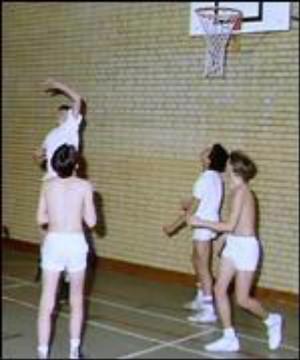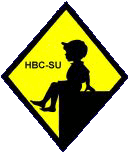
Figure 1.--Not my school, but very like it - even the brickwork is the same. Boys playing basketball, shirts v skins, was something we occasionally did in the 6th form (more often we played volleyball, again shirts v skins). |

|
Our PE and Games kit consisted of white cotton PE shorts, navy blue games shorts, two rugby shirts (one green, the other white), white plimsolls, white ankle socks, coloured rugby socks, rugby boots and a white sweater. We also needed a towel. Both pairs of shorts were quite brief - an inch or so of leg - and loose fitting. At our first PE lesson we discovered how this kit was to be used. For PE in the gym, we were to wear white shorts with plimsolls and, if we wanted, white ankle socks. We were required to strip to the waist. For rugby, we were to wear the navy blue shorts, one or more often both rugby shirts, rugby socks and boots. For PE outdoors in the winter we were to wear the rugby kit, but with plimsolls rather than boots. Outdoors in the summer we were to wear white shorts, a white t-shirt or the white rugby shirt, and plimsolls optionally with white socks. Underwear was strictly forbidden for all PE and games (in the sixth form, one or two boys did wear jockstraps, but the vast majority of us continued without any underwear). After PE or games, we were to strip naked and take a (communal) shower - hence the towel. Most of us kept the kit at school all term. At first, I found it rather strange to be stripped to the waist and not to wear underpants, but I soon got used to it and found it comfortable to run around with very little clothing. I soon preferred to be shirtless for PE whenever possible.
Inevitably the theory and practice of PE kit differed. I never wore the white ankle socks (twenty years later I gave them to my wife!): in fact, I very rarely wore any socks at all with plimsolls - I found them more comfortable without, and in the winter I put comfort before warmth. If your plimsolls were too dirty, you had to do PE in the gym barefoot. Since we wore plimsolls both indoors and out, and I never cleaned them, the inevitable happened and one day, I think in my first term, I was told to do PE barefoot. The following week I hadn�t done anything about the plimsolls, so I went into the gym barefoot. I soon found that I preferred to be barefoot in the gym, and thereafter I very rarely wore more than a pair of thin white shorts in the gym. Since the heating didn�t work very well, it got quite cold in the winter, but it wasn�t draughty so you kept warm provided you kept moving. After a few minutes my bare chest and feet always became acclimatised to the conditions. In the 6th form (1967-69) we tended to play team games in the gym, shirts v. skins; the skins team sensibly always started with those of us (always a few, however cold it was) who were shirtless. I believe that in later years they solved the dirty plimsolls problem by making everyone do PE in the gym barefoot. I think this was introduced progressively so that those who�d been used to wearing plimsolls didn�t change their practice. In the group I was in - about 25 boys - two of us were always barefoot in the gym, plus any others who'd not brought clean plimsolls that day. I also discovered little unpleasantnesses to avoid: for instance, if you had to do press-ups, you didn't leave your bare chest in contact with the floor for longer than you could help. Coconut matting was perfectly all right under bare feet, but unpleasantly prickly if you had to sit on it - thin white shorts gave very little protection. The floor might be cold, but at least it didn�t prick you! The grass outside in the summer could be prickly to sit on, too, if it was dry, and unpleasant if it was wet; in both cases, the answer was to kneel instead of sit.
The showers, after a few weeks, became effectively optional, as a result of which I never showered. Since I usually did my best to avoid getting seriously muddy, this didn�t matter much. It wasn�t that I minded being naked in front of my contemporaries, I simply did not like showering - I still don�t. As I�ve implied, bare feet in the gym were in practice an option for those who preferred them. At least one boy - the other one who was always barefoot in the gym, as it happens - always wore navy blue shorts; I never did find out why.
For those who had forgotten or lost their kit, the choice was, in theory, simple: do without (except, of course, shorts); borrow from someone else (easy for shorts, as we all had two pairs, but not always so for anything else); or find something from lost property. We were strictly forbidden to do PE in the gym with just socks on our feet, as it would be too slippery: if you hadn�t got your plimsolls or if they were too dirty, you had to go barefoot. I remember on one occasion a friend who had left his plimsolls at home asked me what it was like barefoot in the gym. I assured him that it was no problem, and he did the lesson barefoot - but thereafter he remembered his plimsolls! In practice, the rules were observed strictly for the gym, and in the summer outside as well, but generally not in the winter. In the summer, most of us took our shirts off for PE outside anyway, and a few of us went barefoot for such activities as it was sensible (i.e. pretty well anything except cricket). In the winter, it was usually different, and the extent to which the rules were enforced depended on the weather. I never remember seeing, or hearing of, anyone at my school who was made to go shirtless or barefoot outside when it was unpleasantly cold - in fact, the converse was true, that we were sometimes required to wear shirts when we�d have preferred not to. Just occasionally you�d see someone barefoot outside in the winter: perhaps running round the field instead of playing rugby, but not if it was unpleasantly cold. Very rarely, one of the girls would have to play netball barefoot outside in the winter, on the tennis courts. It was expected that if you hadn�t got part of your kit, you�d find something or go without: we knew the rules and worked to them. So if - say - you were doing athletics, and had forgotten your plimsolls, you wouldn�t ask the teacher what to do, you�d just go outside in your bare feet. Both pupils and teachers expected it.
We had always done athletics for outdoor PE in the summer, for which we often took our shirts off, and from my second year I was usually barefoot. From about the fourth year onwards, I did athletics or played tennis in the summer, and did cross-country in the winter, both for outdoor PE and for games. For tennis or athletics I wore just shorts - bare feet and no shirt - and I don't ever remember being unpleasantly cold. One year when I was doing athletics we had PE first thing in the morning, but I soon got used to running barefoot on fairly cold dewy grass. Only one of the tennis courts we used was a bit rough: fortunately my bare feet could cope with it for long enough! All the rest were much smoother and it was common practice, mainly for the girls, to go barefoot on them. As I have said, most of us took our shirts off for PE outside in the summer when we reckoned it was warm enough. Those who did wear shirts could, in practice, wear almost anything so long as it was white. Officially, they should have worn the white rugby shirt: but some wore T-shirts; some wore button-up shirts - one boy often had all the buttons undone, so that his chest was bare, but still wore the shirt; and one boy wore a vest - I always wondered if it was his underwear vest! These last two I thought rather odd, wondering why they didn't strip to the waist like most of the rest of us. For cross-country, what I wore depended on whether it was PE (running on often muddy paths through woodland behind the school) or games (a much longer course on field paths). At most, it would be two rugby shirts, shorts and plimsolls without socks. In icy conditions, my legs and feet got a bit cold but I found it more comfortable without socks, and in any case it was preferable to playing football!
The shirts usually came off as soon as it was just about warm enough; through the woods I usually ran barefoot and/or shirtless unless it was too cold.
Running barefoot on the field paths was impracticable because 1. the local stone was flint and 2. the hedges were hawthorn: both would have been unpleasant or dangerous. What other boys wore for cross country varied somewhat: always shorts and plimsolls (with or without socks) but on top could be rugby shirt(s), a white t-shirt, a sweater, or any combination thereof, or nothing at all if it was warm. I don't remember anyone wearing a running vest. Occasionally a boy would wear rugby boots to run in, but neither teachers nor pupils liked this much.
Of course, as I did cross country for games in the winter, wearing plimsolls, they were always rather muddy so I would not have been allowed to wear them in the gym, even had I wanted to. I always reckoned that cross-country was an easy option which I didn�t mind too much, though boys at other schools sometimes had very different views. We were certainly better off than some - I would say that what we had to do probably counted as good practice by the standards of the day.
